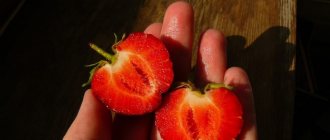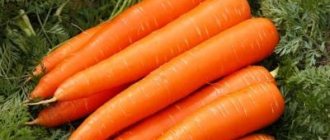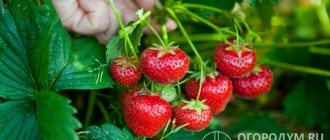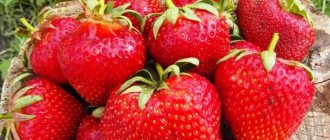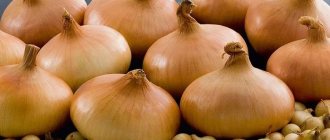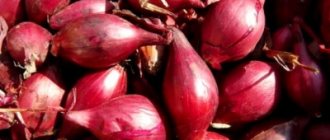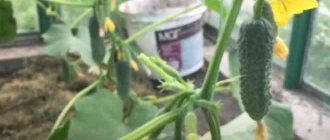The Darselect strawberry was obtained in France in 1998. Its “parents” were the European varieties Parker and Elsanta, popular in the 20th century. Darcelet quickly gained the love of European farmers and is one of the few representatives of the strawberry “community” that are massively cultivated by French agricultural firms for commercial purposes. Its advantages are early ripening and active growth and development within a short daylight hours.
History of the variety's creation
At the end of the last century, French breeders from the Societe Civile Darbonne company carried out work to develop a new strawberry variety that would be distinguished by high yield, disease resistance and some other improved characteristics. They crossed the famous strawberry varieties Elsanta and Parker. The result was a new variety called Darselect, which took its best qualities from its “parents” and also acquired its own:
a wonderful aroma and large size of ripe fruits.
Photo of strawberries Darselect
Interesting!
Although Darselect, unlike Elsanta, produces fewer fruits, they are much larger in size.
Over the decades since the variety was developed, this French strawberry variety has become popular not only among farmers in its native country, but also among gardeners from around the world. And in different regions of France, Darselect strawberries are grown on an industrial scale.
Diseases and pests of garden strawberries Darselect
In order for Darselect strawberries to produce a stable harvest for four to five years, it is necessary to protect the plantation from pests and damage. Prevention of aphid infestation will be by planting garlic between the rows, whose specific smell will repel the larvae. But this measure will not save you from rot or fungal diseases: removing damaged, rotten and old leaves at the beginning of the growing season will help reduce the risk.
Diseases characteristic of Darselect:
- verticellosis (Verticilium albo-atrum);
- powdery mildew (Oidium);
- strawberry mite;
- aphid.
The main measure in the fight against strawberry diseases remains replanting the plantation after five years of cultivation to a new location. Predecessors should also be selected carefully. Successful crops: garlic, onions, flowers with a strong smell (marigolds) and herbs.
Verticellosis
The defeat begins with a change in the color of the leaves and ends with the death of the bush
The disease is a fungal disease. The first signs are wilting of the leaves and reddening of the petioles. The tissues of the root and core die off, as a result of which the bush dies. Since this disease is typical for nightshade crops (potatoes, tomatoes, peppers), strawberries should not be planted after these crops. The spores of the pathogenic fungus remain in the ground for up to three years and infect new plants, penetrating into them through the roots. Therefore, after removing the affected plants, the plantation should be sprayed with Fundazol or Benorad.
Powdery mildew
A barely noticeable white coating leads to the death of the crop
Powdery mildew manifests itself in the defeat of leaves, tendrils, and peduncles with a white coating, the process of pollination and formation of ovaries is disrupted. In the later stages of the disease, the leaves curl and brown necrosis appears on them; the berries become hard, irregularly shaped and covered with a waxy coating, their taste and smell take on an unpleasant earthy hue. The fungus develops in a moist and warm environment. Favorable conditions are created in the greenhouse, but in open ground the disease manifests itself in rainy summers or can be introduced with seedlings. Powdery mildew can be prevented by raising the beds and preventative spraying with Quadris. If signs of disease appear, then bushes without berries are treated with Topaz, Switch, Fundazol, Bayleton.
Aphids and strawberry mites
It is important to detect damaged leaves in time and remove them before the pest spreads throughout the entire plantation.
On damaged bushes, leaves curl, inside of which there is a noticeable accumulation of insects. Not only one leaf can die, but the entire plant. Insecticides are used against pests: Aktara, Aktellik, Aktofit. Followers of organic farming spray bushes infected with aphids with a mixture of garlic, onion and dandelion juice (2:2:1.5 per 10 liters of water) or 6% soap solution.
Strawberry Darselect: description of the variety and main characteristics
This strawberry variety belongs to a common group of this berry crop with short daylight hours. This means that the Darselect variety is not remontant.
and bears fruit only once per season, fruit buds are successfully formed only when daylight hours do not exceed 12 hours.
The roots of Darselect strawberry bushes are powerful and strong. And the bushes themselves grow well in breadth and height. The foliage is typical for strawberries, medium in size, wrinkled, with jagged edges, without pubescence, dark emerald color. Although the plant is very strong and powerful, it does not tolerate periods of drought very well.
Therefore, to obtain high yields and large sweet fruits, it is necessary to follow the irrigation regime. If moisture is added to the soil in sufficient quantities and on time, then the bushes can cope even with heat above 36-38 degrees Celsius. The foliage does not burn or fall off at this temperature.
The number of tendrils formed in Darselect strawberries is average, while you can always collect rosettes for further propagation, but you do not have to regularly remove them.
This strawberry variety is early,
since ripe fruits are collected from bushes already in the second ten days of June. The bushes bloom in the second or third decade of May, when spring frosts are still possible in many Russian regions. The interval between the appearance of flowers and the ripening of fruits in Darselect strawberries is one of the shortest among all varieties of this berry crop - 25-30 days.
Photo of a bush with Darselect strawberries
Strawberry flowers of this variety react negatively to a sharp drop in temperature and can freeze out, as a result of which the yield of the variety is sharply reduced. Therefore, it is necessary to provide temporary shelter for beds with Darselect strawberries - a greenhouse made of metal arcs, onto which any non-woven material is stretched.
On a note!
Fruiting is extended over time, the harvested fruits are harvested within 1.5-2 weeks. The first berries ripen around mid-June.
classify this garden strawberry
The size of the fruits and the overall yield of the Darselect variety directly depends on how often a given strawberry plantation is fertilized.
Description of the strawberry variety Darselect - video
The berries may initially have an oval-conical shape, and as they ripen they become round or heart-shaped. Sometimes the shape of the fruit can be an unusual comb shape. This happens due to a decrease in air temperature or too high humidity at the time of flowering of strawberries, which is why pollination may be worse than usual.
The color of the surface of the berries is red with an orange tint; as they ripen, the fruits develop a characteristic shine.
Excellent varieties of strawberries!
Strawberry Kent Strawberry Cardinal Strawberry Bohemia
The color of the fairly dense pulp is lighter, with a reddish tint. The pulp is elastic, watery and voids are not observed. Darselect fruits do not have a characteristic “crunch” like some other strawberry varieties. The aroma of ripe fruits is like that of real wild strawberries.
The berries separate well from the stalks, do not release juice and do not darken, so they can easily be transported over long distances. The shelf life of the harvested crop under appropriate conditions is at least a week without loss of presentation and taste.
The above qualities make it possible to grow the Darselect variety on an industrial scale, and gardeners often plant this early variety specifically for further sale.
Interesting!
The taste qualities of ripe fruits of Darselect strawberries are exquisite and multifaceted, which allowed the tasters to give the berries the highest score - 5.
Ripe fruits are distinguished by their versatility of use - they can be eaten fresh, prepared with them in desserts, canned - made jam, preserves, compotes, and also frozen for the winter.
INTERESTING!
The best varieties of strawberries for the Moscow region
The relative disadvantages of the variety include the low frost resistance of the Darselect variety.
Since breeders bred this strawberry for different regions of France, the cold resistance of the Darselect variety is low - up to -16 degrees Celsius without shelter.
Unfortunately, after 3-4 seasons, the berries of this variety of strawberries begin to become smaller, so it is recommended to replace the plantations with new plants after a couple or three seasons.
As a result, when growing this berry crop in most Russian regions, before the onset of winter, it is necessary to cover the strawberry plantation with spruce branches, straw or other materials.
Characteristics of berries
As you know, the most important thing in strawberries is the berries. And in this regard, it’s even hard to believe that Darselect strawberries are usually classified as commercial varieties - their berries are so tasty and aromatic.
- The strawberry variety Darselect can be safely classified as large-fruited. Indeed, with an average weight of one berry of 20-30 grams, specimens weighing up to 50 grams are quite often encountered. Moreover, both the mass of individual berries and the yield directly depend on the frequency and regularity of fertilizing.
- The shape of the berries during the season can change from conical-oval to round, heart-shaped at the end of fruiting. In some cases, at the end of the season, oddly shaped berries with a ridged surface may appear. These deformations may be a result of low temperatures or high humidity during flowering, which can cause poor pollination.
- The color of Darselect strawberries is red with an orange tint. When fully ripe, the skin may become shiny.
- The flesh has a lighter red tint. It is dense, elastic, without wateriness. Although it does not “crunch” like some modern commercial varieties, such as Albion.
- After picking, the berries are stored well, do not darken or leak. They tolerate transportation well even over long distances.
- Well, the taste of Darselect strawberries is distinguished by its sophistication and versatility. It has enough sugar, but at the same time there is a subtle sourness. According to tasters, it scores 5 points on a five-point scale. The berries are also characterized by the unique aroma of real wild strawberries.
Advantages and disadvantages
The main positive qualities of the Darselect strawberry variety include:
- early ripening of fruits;
- large fruit;
- good presentation and taste of ripe berries;
- the bushes produce an average number of tendrils, so their regular removal is not required;
- the variety is characterized by high yield for short-day strawberries;
- the harvested crop tolerates transportation well over long distances and can be stored for quite a long time (unlike many other varieties of strawberries).
But this variety also has its drawbacks:
- it is not very resistant to many diseases, so it is necessary to carry out preventive treatments of the bushes;
- flowering occurs during the period of possible spring frosts, so flowers often suffer from low temperatures;
- bushes are demanding in terms of watering regime.
Growing strawberries
No more than 4 plants are planted per 1m2. This variety, unlike many others, does not require long daylight hours. Therefore, Darselect can be planted in both shade and partial shade. A plant planted under a tree will bear fruit normally without loss of berry quality.
This variety is grown in different regions, ranging from hot to cold. Frequent watering and proper fertilizing are guaranteed to ensure good yields.
The plant has good immunity, protecting it from many diseases. Most often, bushes are affected by spider mites or purple spot. There are no problems with other diseases.
Bushes are propagated using tendrils or directly from seeds. In the second year after planting, strawberries begin to actively bear fruit. You should not expect a good harvest in the first year. Therefore, many experienced gardeners remove flower stalks in the first year of life in order to increase the foliage mass and volume of the bush.
The berries are dense, so they easily survive transportation over long distances.
The plant is not afraid of temperatures dropping to -20 C.
The bushes bear fruit for no more than 4 years. Next, there is a rapid degradation of the external and taste qualities of the berry.
A great way to improve plant life is to mulch. Straw, sawdust, dry grass, etc. are suitable for this.
In early spring, after the snow has subsided, the bushes are fed with liquid manure. To do this, use either mullein or chicken droppings. In the case of the second, the proportions of dilution with water are twice as high in favor of water than when mixing mullein.
Before setting flower stalks and directly ripening the berries, strawberries can be fertilized with wood ash and saltpeter.
In the fall, when preparing the plants for hibernation, they are fertilized with mineral fertilizers. You should completely forget about nitrogenous fertilizers, as they promote faster growth, and it is not needed in the fall.
Strawberry Darselect: how to plant a berry plant correctly
The bushes of this variety are strong and powerful, which should be taken into account when planting Darselect strawberries on the site. Usually no more than 4 plants are planted on one square of area. The distance between planting holes in a row should be about 0.4 m, and the distance between adjacent rows should be 0.8-0.9 m.
Photos of planting strawberries Darselect
Typically, Darselect strawberry seedlings are purchased from nurseries or online. In this case, Darselect strawberry seedlings are sent in containers with a closed root system. In this case, the roots are protected from diseases, but the foliage should also be inspected - it must be healthy and without signs of disease.
Reviews from gardeners and summer residents
It is understandable that a commercial strawberry variety can receive positive feedback from farmers, but what is surprising is that ordinary summer residents and gardeners are also happy to grow Darselect strawberries in their garden plots.
Sergey, 35 years old, Volgograd
Darselect heard about strawberries from a friend, a farmer, who shared the planting material with me. To be honest, I didn’t even expect that strawberries could be so tasty. A real delicacy! Of course, it requires a lot of care - in the first year I got tired of watering it every day, so for the second season I installed a drip tape from a barrel. Now I barely have time to fill it - these strawberries consume so much water. For the winter I simply wrap it in straw, and the bushes survive the winter quite well. But when harvest time comes, the whole family gathers to admire the miracle berry.
Valentina, 52 years old, Izhevsk
I have tried many varieties of strawberries in my life and I cannot say that I am very delighted with many modern varieties. Many seem somewhat rubbery. But then I prescribed a couple of Darselect bushes and changed my mind. Indeed, very tasty strawberries, and at the same time so large, even, and beautiful. True, in our area it requires shelter for the winter. But, thank God, recently so many covering materials have appeared on sale, of all kinds, that there are no problems with this either.
Ekaterina, 28 years old, Yeisk
I’ve been wanting to plant strawberries on my plot for the children for a long time, but I still couldn’t choose the right variety. My husband brought several different varieties, including Darselect. The berries appear early, already around the tenth of June. The size of the berries is impressive, they are as even as a selection. Well, the taste and aroma are just real strawberries from childhood. I am very pleased and now recommend this variety to everyone.
Further care for Darselect strawberries
Further care of Darselect garden strawberry bushes primarily involves observing the irrigation regime, since despite the developed root system, these bushes are demanding on the moisture content of the soil in which they grow.
With a lack of moisture and too infrequent watering, the bushes often dry out and die. During drought, voids may form in ripening fruits.
Experts recommend using drip irrigation to water strawberry plantations in regions with hot climates.
This irrigation method is especially relevant when growing Darselect strawberries on an industrial scale.
Strawberry variety DARSELECT (France) - video
Subject to regular, abundant watering, the bushes of this berry crop tolerate hot weather well, but the ripening of the fruit is delayed by 6-8 days.
Advice!
Often, when growing Darselect strawberries, a special shading net is used, or they are planted in partial shade.
In the first year after planting, the yield of this variety is not high, since the bushes actively grow and develop the root system. In the first season after planting the bushes, many gardeners remove the emerging buds to allow the bushes to develop well.
Fertilizing a strawberry plantation of the Darselect variety
This strawberry variety does not grow well in carbonate soils, and as a result, symptoms of chlorosis may appear on the foliage. In this case, it is necessary to fertilize “by leaf,” and after just a couple of such fertilizing, the foliage will restore its color.
Rules for feeding strawberries!
Fertilizing strawberries for a large harvest in spring, summer and autumn
This variety requires regular fertilizing with complex mineral fertilizers every 12-14 days.
With constant fertilizing, the yield of the variety increases sharply.
Early ripening variety Darselect, one of the sweetest varieties - video
Preparing Darselect strawberries for winter
In preparation for the winter period, moisture-recharging irrigation should be carried out and fertilizers containing phosphorus and potassium should be applied.
Before the onset of frost in cold regions, strawberries need to be covered. Fir branches, straw, fallen leaves and any non-woven material can be used as covering material.
Landing
Darselect strawberries, like their relatives, require a sunny, well-lit place without drafts. Planting on a slight slope is possible, but not in lowlands, where berry growers are at risk of excessive waterlogging.
Basic landing rules:
It is recommended to plant seedlings in the fall, in advance of frost, so that they have time to take root and prepare for the winter period. You can also plant in the spring. During spring planting, the first year they get rid of the ovaries so that the plants become stronger and spend energy only on building up green mass and growing the root system.
Use a ribbon or checkerboard planting method, maintaining a distance of at least 30x30 cm between bushes.
The holes are dug to a sufficient depth so that the root system of the seedling has enough volume of the hole to prevent the roots from bending. Trimming the root tips of this variety is not recommended.
A handful of humus and a little ash are added to the hole, the plant is planted, watered, and mulched with peat or sawdust.
Note: Planting in agrofibre has become a popular way of cultivating strawberries. Cuts are made in the film crosswise every 30 cm. Holes are dug in the cuts and strawberry bushes are planted. This way they are protected from weeds and there is no need for loosening.
What is Darselect
Not every gardener, especially in the outback, has heard of Parker strawberries. But the name of the Elsanta variety is familiar to the army of summer residents. The standard garden strawberry – Elsanta is not called anything else. At the turn of the millennium, the French crossed these varieties, obtaining worthy offspring from recognized parents - Darselect. With such an eminent pedigree, the new product quickly conquered Europe.
Russian, Ukrainian, Belarusian gardeners and farmers are taming a Frenchwoman with character: the Darselect strawberry is sometimes hot, sometimes windy, sometimes dry, sometimes cold. But gardeners are working hard, trying to adapt the variety to unusual conditions.
Varietal features
The Darselect variety is characterized by the following:
- Medium-early ripening dates: in the south closer to early, in the Central regions - to medium.
- Not repairable. According to reviews, there are attempts to bloom in the fall when the weather is favorable. But the bushes do not produce a harvest.
- Large-fruited: with a minimum of effort - 20-30 g. For the additional investment of labor and time, 50 g will be rewarded with berries. Record holders for the first fruits of the season - 70 g.
- Productive: at least 600-700, if you don’t invest too much. A diligent gardener will receive up to 1.2 kg.
- It can withstand heat with difficulty if there is not enough moisture. Water shortages not only reduce crop yields. Plantations die if they are not watered on time.
- It will not survive on leached soils with a high content of carbonates. Such soils are characterized by a pH above 7. And strawberries love a slightly acidic or neutral environment.
- “Darselect” resists rot and spotting, but rarely copes with verticillium and powdery mildew without prevention.
- Peak productivity is in the 2nd-3rd year, after which the plantation is renewed.
- The growth is sufficient to replace outdated bushes with young rosettes.
- Manufacturers claim frost resistance is below average: if the temperature drops to -20, and the beds are not prepared for wintering, even a snow cushion will not save. Without any problems, Darselect overwinters with gardeners and farmers from regions with mild winters. And Siberians have to reliably cover their beds.
- Presentation, shelf life, transportability - three more reasons for the highest rating.
Industrialists value the variety for the short period between the first flower and the ripe berry. Capricious in the open air, strawberries are docile and generous in greenhouses, and ripen simultaneously with the earliest ripening varieties.
Bush and fruits
Powerful upright bushes with dark green leaves and tall peduncles are cramped with standard planting. A generous gardener allocates half a meter to the bushes if he plants them in 2 rows, or 40 cm between holes if they are planted in a checkerboard arrangement.
The roots are strong, but in drought they cannot cope with the extraction of moisture. Drip irrigation is the only salvation if the summer resident comes to the site only on weekends.
Darselect berries, no matter what appearance they take, are beautiful:
- Heart-shaped;
- Correctly conical;
- With a blunt tip;
- With a comb.
In the photo - berries of the French variety:
Such variations are the result of weather, humidity, and fertilizing. Rich orange-scarlet color, glossy sides, juicy flesh. The berries are universal - good fresh or prepared or frozen.
A brief overview of strawberries - in the video:
How to choose the best seedlings for planting when purchasing?
To be sure of the quality of seedlings, you should buy them from trusted sellers. It is even better to make such a purchase in specialized nurseries. They sell already healthy seedlings that take root faster, are not afraid of diseases and pests, and are distinguished by their productivity. This is especially important if you plan to plant strawberries for commercial purposes.
Find out how to preserve strawberry seedlings before planting.
When choosing seedlings, you need to pay attention to its appearance:
- in spring, the seedling, in addition to old leaves, should have 2-3 young ones;
- the leaves are strong, leathery, pubescent, beautiful green in color with a characteristic shine; pale color and defects (wrinkling and spots) are signs of disease;
- the horns are healthy, powerful, no thinner than 0.7 cm, light green in color;
- The roots are dense, branched, no shorter than 7 cm.
Care
When the bushes begin to bloom for the first time, all flowers need to be cut off. This stimulates further fruiting of the berry and improves its quality. In subsequent years, the flowers are not picked off; it is enough to perform the procedure once during the entire life of the plants. When the strawberries bloom in the second year, they need to be fed with potassium fertilizer. Take any potassium salt and dilute it with a tablespoon. substances per 10 liters of water. Plants need to be watered at the root; the foliar method is not used so that water does not get on the berry buds.
An alternative to potash fertilizers is ordinary ash: Darselect reacts well to it. Ash can be diluted in water (1 glass per bucket of water) or added when mulching the soil.
Attention! Ash can be purchased from gardening supplies.
In early spring and autumn, diseased shoots, dry leaves and stems are removed from strawberries. Sanitation is necessary for bushes, and neglecting it becomes the cause of diseases. To protect the berries from infection with viruses and fungal diseases, strawberry bushes are sprayed with a solution of copper sulfate or Fitosporin. The substances prevent the development of bacteria, so the strawberries will be healthy throughout the entire ripening period.
Origin and official registration
“Darselect” was bred by breeders of the research center for the development of new varieties of fruit and berry crops Planasa (Le Barp, France) in 1998 by crossing the recognized leaders “Elsanta” and “Parker”. The variety is adapted to the continental climate, therefore it is suitable for cultivation in open ground in the middle zone and southern regions of Russia, almost throughout the entire territory of Ukraine and Belarus. Productive in greenhouses and greenhouses, suitable for growing in small containers (hanging pots or balcony boxes). The variety also demonstrates excellent results on substrate and hydroponics.
The variety has not received official registration in the State Register of the Russian Federation, but its distribution involves both prestigious foreign nurseries of strawberry seedlings (Flevoplant, Planasa, Van den Elzen, Henselmans, etc.) and agricultural firms in Russia and other post-Soviet countries that sell planting imported or home-produced material.
When purchasing strawberry seedlings, do not forget that advertising descriptions may not actually live up to gardeners’ expectations. The productivity of the variety and the taste of the berries, like any other variety of crop, largely depend on the weather and climatic conditions of the growing region and the level of intensity of agricultural technology.
Features of agricultural technology
Darselect garden strawberries are not for beginners who have not yet mastered the skill of recognizing the needs of a berry crop. If you treat the agricultural technology of the described variety as unnecessary care (other strawberries grow on their own!), then you won’t even be able to taste a 5-point berry. Labor, and during unfavorable weather periods, daily attention - these are the conditions when a gardener receives a worthy reward.
Standard agricultural technology in strawberry beds for those who live in a comfortable climate:
- mild short winter with snow;
- generous sun that does not burn the greenery;
- fertile lands;
- periodic rains.
In other regions, you will have to make an effort to get what you want from Darselect.
Harvest and storage
The berries are picked in the morning or afternoon. The stalk of the Darselect strawberry is not rigid, so harvesting the berries occurs without difficulty and very quickly. The fruits are collected in several stages as they ripen. After picking the berries, they are sorted: the damaged ones are removed, the healthy ones are placed in a hard and dense container.
The berries are placed in a hard and dense container
The berries will keep in the refrigerator for about 5 days. Then they become soft and lose their attractive appearance. For longer preservation, strawberries are frozen.
Planting seedlings
The area for bushes is chosen to be flat, without hills or valleys. You can’t plant strawberries on a slope, the maximum is a flat hill, without bumps and holes.
A flat area in the sun is an ideal place for strawberries.
It is unacceptable to create a bed in a draft or in shaded areas . The site should be located on the south or south-east side of the garden, well lit from all sides. But the site must also be located in a convenient place so that a drip irrigation system can be installed.
Scheme
Due to the fact that the bush has a powerful root system, planting should be carried out according to the standard scheme - place four plants on one square meter.
- The distance between the bushes is from thirty to thirty-five centimeters, since maximum yield results can be obtained only after the rhizome has fully grown and strengthened.
- The depth of the hole in this case should be forty centimeters due to the fact that it is not recommended to shorten the roots of such varieties.
The recommended planting pattern is two-row, on a shaft.
As a rule, two planting patterns are used - in rows and in a checkerboard pattern. Most often, gardeners use a checkerboard pattern. The crop can bear fruit in one place for up to four years, then the bushes should be moved to another place and young seedlings should be planted.
